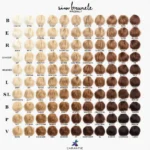Choosing the right under-eye concealer can feel like a never-ending quest. You’re faced with countless shades, formulas, and promises of a brighter, more awake look. But the key to truly banishing those dark circles and imperfections lies in selecting the perfect color match. It’s not just about finding a shade lighter than your skin tone; it’s about understanding undertones and color correcting to achieve a flawless finish.
Decoding Your Skin Undertone: The Foundation of Concealer Selection
Before you even glance at the concealer aisle, take a moment to determine your skin’s undertone. This underlying hue plays a crucial role in how colors appear on your skin. There are three primary undertones:
- Warm: Characterized by golden, yellow, or peachy hints.
- Cool: Features pink, red, or bluish undertones.
- Neutral: A balanced blend of warm and cool undertones.
Pro Tip: Look at the veins on your wrist. If they appear greenish, you likely have a warm undertone. Blueish veins suggest a cool undertone, while a mix indicates a neutral undertone.
Targeting Concerns: Choosing the Right Concealer Shade
Now that you’ve identified your undertone, let’s address specific concerns:
Dark Circles:
- For bluish-purple circles (common in fair to light skin tones): Opt for a peach or salmon-toned concealer. These warm shades counteract the blue, effectively neutralizing darkness.
- For brownish-green circles (common in medium to deep skin tones): Choose an orange or reddish-orange concealer to counter the green tones and brighten the under-eye area.
Redness:
- A green-tinted concealer will effectively neutralize redness caused by blemishes, broken capillaries, or rosacea.
Hyperpigmentation:
- For brown spots or melasma: Peach, orange, or yellow-based concealers can help to counteract and brighten areas of hyperpigmentation.
Brightening:
- To add a touch of brightness and lift, choose a concealer one or two shades lighter than your foundation, but ensure it still complements your undertone.
Finding Your Perfect Match: Tips for Choosing Concealer
- Test in Natural Light: Always swatch concealers in natural light to get the most accurate representation of the color.
- Don’t Be Afraid to Mix: Experiment with mixing concealers to find your perfect shade, especially if you have unique undertones.
- Consider the Formula: Choose a creamy, hydrating formula for the under-eye area to avoid creasing.
- Set with Powder: Set your concealer with a light dusting of translucent powder to ensure long-lasting wear.
 Woman matching concealer to her wrist
Woman matching concealer to her wrist
Beyond Color: Additional Factors to Consider
- Coverage: Choose a light to medium coverage concealer for everyday wear and a full coverage option for special occasions or to conceal more prominent imperfections.
- Finish: Matte finishes provide a flawless look, while luminous or radiant finishes add a touch of brightness to the under-eye area.
- Ingredients: If you have sensitive skin, look for fragrance-free and hypoallergenic formulas.
 Close-up of a makeup brush blending concealer under the eye
Close-up of a makeup brush blending concealer under the eye
The Takeaway: Achieving a Flawless Look
Choosing the right under-eye concealer color is an art that involves understanding your skin tone, undertone, and specific concerns. By following these tips and experimenting with different shades and formulas, you’ll be well on your way to achieving a brighter, more refreshed look that enhances your natural beauty.
Frequently Asked Questions
1. Can I use my foundation as concealer?
While you can use foundation in a pinch, it’s not ideal. Concealers are typically more pigmented and offer better coverage for targeted areas like the under-eye.
2. How do I prevent my concealer from creasing?
Start by applying an eye cream and allowing it to fully absorb. Then, use a small amount of concealer and blend it well. Setting with a translucent powder can also help to prevent creasing.
3. What’s the best way to apply concealer?
You can use a brush, sponge, or your fingers to apply concealer. A small, fluffy brush or a damp makeup sponge can help to create a seamless blend.
4. How often should I replace my concealer?
It’s a good idea to replace your concealer every 6 to 12 months, or sooner if you notice any changes in texture or smell.
5. I’ve tried everything, but I still can’t find the right concealer shade. What should I do?
Consider visiting a makeup counter for a professional color match. They can help you find the perfect shade and formula for your skin type and concerns.
Need More Help?
For personalized advice on choosing the perfect concealer and creating a flawless makeup look, contact us at:
Phone: 0373298888
Email: [email protected]
Address: 86 Cầu Giấy, Hà Nội.
Our team of beauty experts is available 24/7 to answer your questions and provide tailored recommendations.

